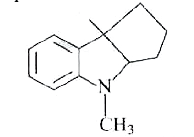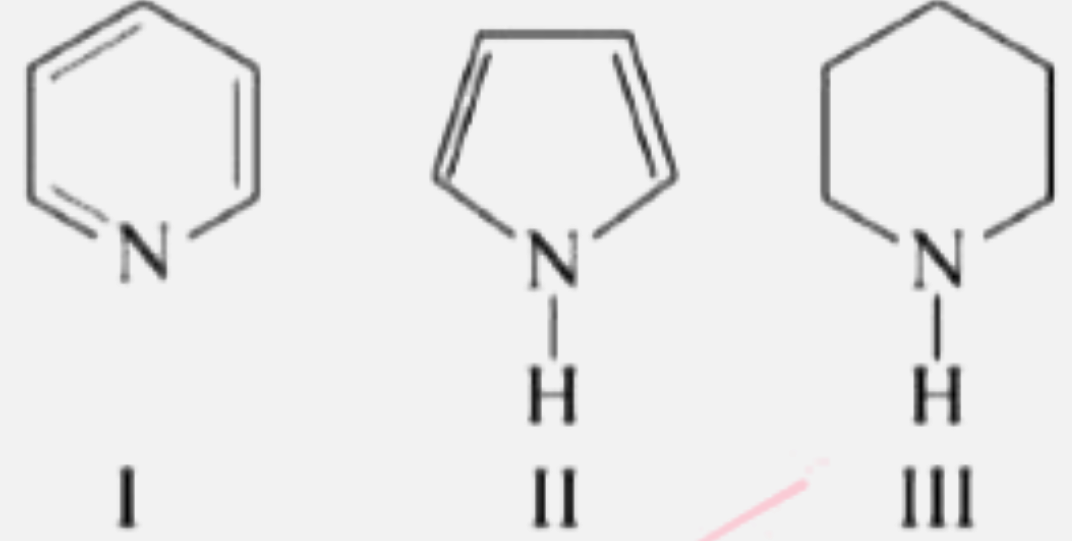The nitrogen atom in each of the following tertiary amines may be removed as trimethyl amine by repeated Hofmann elimination.
Which of the following amines requires the greater number of Hofmann sequence to accomplish this?




The correct Answer is:A
To determine which of the given tertiary amines requires a greater number of Hofmann eliminations to remove the nitrogen atom as trimethylamine, we can analyze the structure of each amine option. The Hofmann elimination involves the formation of a stable nitrogen intermediate, which can be removed as trimethylamine.
1. Understand Hofmann Elimination:
- In Hofmann elimination, a tertiary amine is converted to an alkene by the removal of the nitrogen atom as trimethylamine. This occurs through the formation of an N-oxide intermediate, which then undergoes elimination.
2. Identify the Structure of Each Amine:
- Analyze the structures of the four options provided (let's denote them as A, B, C, and D). Each structure will have a nitrogen atom bonded to three methyl groups and potentially other groups.
3. Determine Stability of the Nitrogen Intermediate:
- The nitrogen atom must form a positively charged intermediate (N+) during the elimination. The stability of this intermediate is crucial for the ease of elimination.
- A planar structure around the nitrogen atom (sp² hybridization) is required for efficient elimination.
4. Evaluate Each Option:
- Option A: This amine is part of a cyclic structure, which may hinder the formation of a planar nitrogen intermediate.
- Option B: Similar to A, if it also contains a cyclic structure, it may also hinder elimination.
- Option C: This amine has a structure that allows for a planar arrangement around the nitrogen, making it easier to undergo Hofmann elimination.
- Option D: If this amine is also cyclic, it may also hinder the elimination process.
5. Count the Number of Hofmann Eliminations:
- For each option, consider how many times the Hofmann elimination would need to occur to fully remove the nitrogen atom as trimethylamine.
- The more hindered the nitrogen is (due to cyclic structures or steric hindrance), the more Hofmann eliminations will be required.
6. Conclusion:
- After analyzing the structures, it becomes clear that options A, B, and D may require more Hofmann eliminations due to their cyclic nature, while option C is more favorable for elimination.
- The option that requires the greatest number of Hofmann eliminations will be the one with the most steric hindrance or cyclic structure that prevents easy removal of nitrogen.
Final Answer:
- The amine that requires the greater number of Hofmann eliminations is Option A or Option D (depending on the specific structures provided).
- In Hofmann elimination, a tertiary amine is converted to an alkene by the removal of the nitrogen atom as trimethylamine. This occurs through the formation of an N-oxide intermediate, which then undergoes elimination.
- Analyze the structures of the four options provided (let's denote them as A, B, C, and D). Each structure will have a nitrogen atom bonded to three methyl groups and potentially other groups.
- The nitrogen atom must form a positively charged intermediate (N+) during the elimination. The stability of this intermediate is crucial for the ease of elimination.
- A planar structure around the nitrogen atom (sp² hybridization) is required for efficient elimination.
- Option A: This amine is part of a cyclic structure, which may hinder the formation of a planar nitrogen intermediate.
- Option B: Similar to A, if it also contains a cyclic structure, it may also hinder elimination.
- Option C: This amine has a structure that allows for a planar arrangement around the nitrogen, making it easier to undergo Hofmann elimination.
- Option D: If this amine is also cyclic, it may also hinder the elimination process.
- For each option, consider how many times the Hofmann elimination would need to occur to fully remove the nitrogen atom as trimethylamine.
- The more hindered the nitrogen is (due to cyclic structures or steric hindrance), the more Hofmann eliminations will be required.
- After analyzing the structures, it becomes clear that options A, B, and D may require more Hofmann eliminations due to their cyclic nature, while option C is more favorable for elimination.
- The option that requires the greatest number of Hofmann eliminations will be the one with the most steric hindrance or cyclic structure that prevents easy removal of nitrogen.
- The amine that requires the greater number of Hofmann eliminations is Option A or Option D (depending on the specific structures provided).
Similar Questions
Knowledge Check
Only one of the following amines will lose its nitrogen atom as trimethyl amine by repeated Hofmann elimination reactions :
A B
B C
C D
D
Which one of the following amines is the weakest base?
View SolutionWhich of the following is a primary amine .?
View SolutionWhich of the following is a 3∘ amine
View SolutionWhich of the following is a 3∘ amine
View SolutionWhich of the following is 3∘ amine?
View SolutionWhich of the following is aromatic amine?
View SolutionWhich of the following is an amine hormone ?
View Solution


